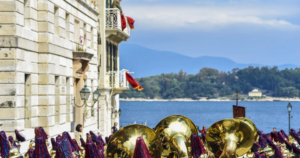Today, the windows and balconies of Corfiots are adorned with crimson-purple “damask” to honor and give prominence to Palm Sunday, for the majestic procession of the holy icon of Saint Spyridon, commemorating the miracle of the island’s deliverance from the plague in the early 17th century.
The sacred icon of the Saint will remain at the gate until Easter Tuesday, when thousands of faithful who will have arrived on the island will rush to worship him.
Earlier, the procession is more than just magnificent, as the procession following the imaginary line of the Venetian walls is accompanied by the island’s 18 Philharmonic bands.
The “damask” fabrics are now displayed in Corfu – What do they symbolize?
The “damask” fabrics are deep crimson or purple, velvet or silk, with golden fringes. They are called “damask” because the fabrics used to arrive on the island, following a special order, from Damascus in Syria. They underwent special processing and were dyed with the well-known “royal” dye, the indelible purple from shells, known since ancient times.
Every house, especially in the city of Corfu, has its “damask.” While today they may not be as luxurious as in the past, most of them are silk. The Corfiots place them on windows and balconies with intense religious devotion to honor the island’s patron saint during every procession of the holy icon. As a sign of mourning from Holy Wednesday until the morning of Holy Saturday, they will be withdrawn from the windows. With the first Resurrection, the houses will be decorated again to celebrate the joyous event. The “damask” fabrics will remain on windows and balconies until Thomas Sunday in many homes.
The purple fabrics are directly associated with the faith of the Corfiots in Saint Spyridon. A characteristic incident occurred in Corfu in December 2019 when a fire completely destroyed a house in the Mantouki neighborhood, except for the “damask” on the window. At that time, a firefighter posted a photo on social media of the burnt house holding a “damask” in his hands and wrote:
“…from our investigation two days after the fire of the building in Mantouki. The only thing that withstood the fiery storm was the banners we use in the processions of Saint Spyridon. It came to my mind that shortly before the event was His feast day….”
Lipsi Greece: The video clip-invite for Easter on the Dodecanese island

The “damask” is a very ancient custom that dates back centuries. Sources indicate that it arrived on the island after the fall of Byzantium when various officials and nobles arrived in Corfu. Long purple fabrics from the Byzantine era hung on the walls and palaces when they celebrated victories or the name days of emperors.
The Venetians took the custom from the Byzantines, and they transferred it again to Corfu, but not as “damask” but as “festoni,” from the Italian word “festone,” meaning festoon.






































